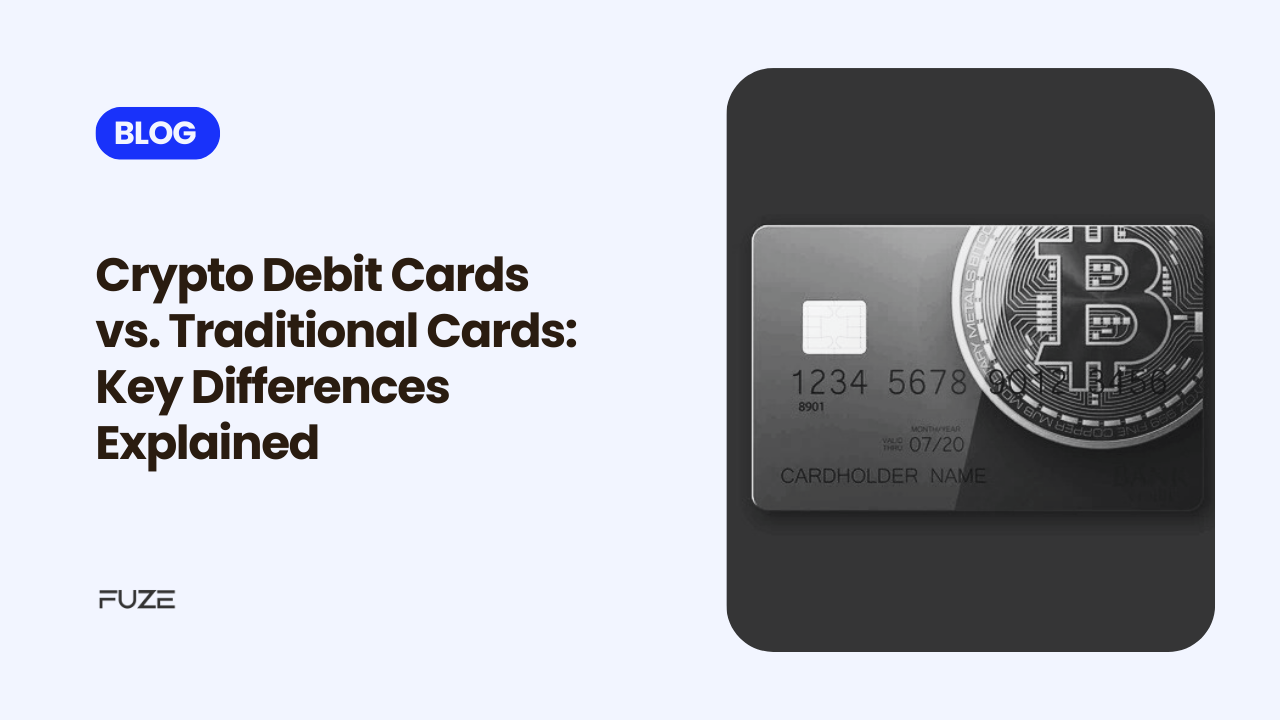The delineation between traditional banking and cryptocurrencies is already fast fading in the midst of today’s fast-evolving landscape. Amongst such confluence are crypto debit cards. To begin with, these cards integrate the digital world with daily transactions: in this case, it’s now easy for users to spend cryptocurrency like fiat money. But how do crypto debit cards stack up against traditional cards?Let’s delve into their key differences to help you understand their unique features and benefits.
What Are Crypto Debit Cards?
Crypto debit cards are payment cards that allow users to use their cryptocurrency for purchases at merchants that accept standard debit or credit cards. They work by converting cryptocurrency into fiat currency at the time of the transaction, allowing for smooth purchases without requiring the merchant to deal with crypto directly.
These cards are typically issued by platforms that work with payment networks like Visa or Mastercard, which allows the card to be accepted anywhere. Users of cryptocurrencies, in particular, appreciate its ease of integration of the digital currencies into daily spending.
Traditional Debit and Credit Cards
Traditional debit and credit cards are payment tools tied directly to a bank account or a line of credit. They allow users to spend fiat money, withdraw cash, and make online or in-store purchases easily. These cards, issued by banks and financial institutions, are accepted everywhere around the world and have added benefits like cashback, reward points, and fraud protection.
Key Differences Between Crypto Debit Cards and Traditional Cards
- Underlying Currency
- Crypto Debit Cards: These cards allow transactions backed by cryptocurrencies like Bitcoin, Ethereum, or stablecoins. Users can either spend directly in crypto or have their funds converted to fiat before making a payment.
- Traditional Cards: These cards function exclusively with fiat currencies such as USD, EUR, or GBP, drawing funds from a bank account or credit line.
- Conversion Process
- Crypto Debit Cards: They automatically convert cryptocurrency to fiat at the moment of the transaction. The conversion rates are influenced by market conditions, and users might face fees for this service.
- Traditional Cards: There’s no need for conversion, as all transactions are conducted directly in fiat currency.
- Global Accessibility
- Crypto Debit Cards: They provide a financial option for people in areas with limited access to traditional banking services. Users can load their cards with crypto and use them wherever the card is accepted.
- Traditional Cards: These require a bank account or credit history, which can restrict access in underbanked regions.
- Volatility Exposure
- Crypto Debit Cards: The value of cryptocurrencies can vary widely, impacting purchasing power. To reduce this volatility, stablecoins are frequently utilized.
- Traditional Cards: Fiat currencies tend to be more stable, ensuring a more predictable purchasing power.
- Fees
- Crypto Debit Cards: Users may encounter fees for converting crypto to fiat, loading the card, withdrawing cash from ATMs, and processing transactions.
- Traditional Cards: Common fees include annual maintenance charges, foreign exchange fees, and ATM withdrawal costs.
- Rewards and Benefits
- Crypto Debit Cards: Many offer crypto cashback, allowing users to earn rewards in Bitcoin or other digital assets with each purchase.
- Traditional Cards: Rewards typically consist of cashback, loyalty points, or travel miles, which can be redeemed within fiat-based systems.
Benefits of Crypto Debit Cards
- Bridging the Crypto-Fiat Gap: Crypto debit cards facilitate the use of digital currencies in real-world scenarios, effectively linking blockchain technology with traditional commerce.
- Global Acceptance: With support from major payment networks like Visa and Mastercard, crypto debit cards are widely accepted wherever traditional cards are used.
- Crypto Rewards: Users can earn cryptocurrency rewards, which offers a unique benefit compared to conventional card loyalty programs.
- Financial Inclusion: These cards provide a practical payment solution for those who are unbanked or underbanked, especially in developing countries.
- Privacy and Autonomy: Crypto users can exercise more control over their funds than they typically would with traditional banking systems.
Challenges of Crypto Debit Cards
- Volatility: The unpredictable nature of cryptocurrencies can make budgeting and spending more difficult.
- Fees: Conversion and transaction fees can diminish the value of rewards or lower overall cost-effectiveness.
- Limited Crypto Support: Some cards only accept a limited number of cryptocurrencies, which can restrict their attractiveness to a wider audience.
- Regulatory Uncertainty: Fast-changing regulations can impact the availability or functionality of crypto debit cards in specific areas.
Which Card Should You Choose?
Your choice between using a crypto debit card or a traditional card is determined by your financial goals and usage habits:
- Crypto Debit Cards: Ideal for crypto enthusiasts who want to spend their digital assets seamlessly, earn crypto rewards, or access banking alternatives.
- Traditional Cards: Best for users who prioritize stability, broad acceptance, and well-established consumer protections.
For those with a foot in both worlds, it’s not uncommon to use both types of cards. Crypto debit cards can complement traditional cards, offering flexibility and new financial opportunities.
The Future of Crypto Debit Cards
As cryptocurrencies continue to gain traction, we can expect crypto debit cards to evolve into more versatile and user-friendly options. Features such as support for multiple currencies, integration with decentralized finance (DeFi) platforms, and improved privacy measures could make these cards a common choice for daily financial transactions.
Additionally, with growing interest from institutions and clearer regulations, crypto debit cards may soon compete with traditional cards in terms of benefits and usability.
Conclusion
Both crypto debit cards and traditional cards have their unique advantages and disadvantages, serving different financial needs. While traditional cards are still a fundamental part of the global financial system, crypto debit cards are quickly becoming a significant tool for incorporating digital assets into daily life. By recognizing their differences, you can make a well-informed choice and take advantage of the best features from both types of cards to manage your finances effectively.
Disclaimer: Virtual assets carry significant risks, including high volatility and potential loss of your entire investment. They are not backed by governmental protections, and recourse may be limited in case of loss. Always assess your risk tolerance, fully understand the risks, and seek independent financial advice if needed before investing.
Frequently Asked Questions
1. Are there fees associated with crypto debit cards?
Yes, common fees include crypto-to-fiat conversion fees, card issuance fees, ATM withdrawal fees, and transaction fees. These vary by card provider.
2. Is using a crypto debit card safe?
Yes, crypto debit cards are generally secure, as they are backed by reputable card issuers and payment networks. However, users should choose trustworthy providers and follow best practices for crypto storage.
3. What are the limitations of crypto debit cards compared to traditional cards?
Crypto debit cards may have fewer consumer protections, are subject to crypto volatility, and may incur higher fees. They also depend on reliable crypto-to-fiat conversion services.
4. Who should use a crypto debit card?
Crypto debit cards are ideal for cryptocurrency holders who want to spend their assets directly, earn crypto rewards, or access financial services without traditional banks.
5. Can I hold multiple cryptocurrencies on a crypto debit card?
Many crypto debit cards support multiple cryptocurrencies, but availability depends on the provider. Some cards also allow seamless switching between supported assets.







